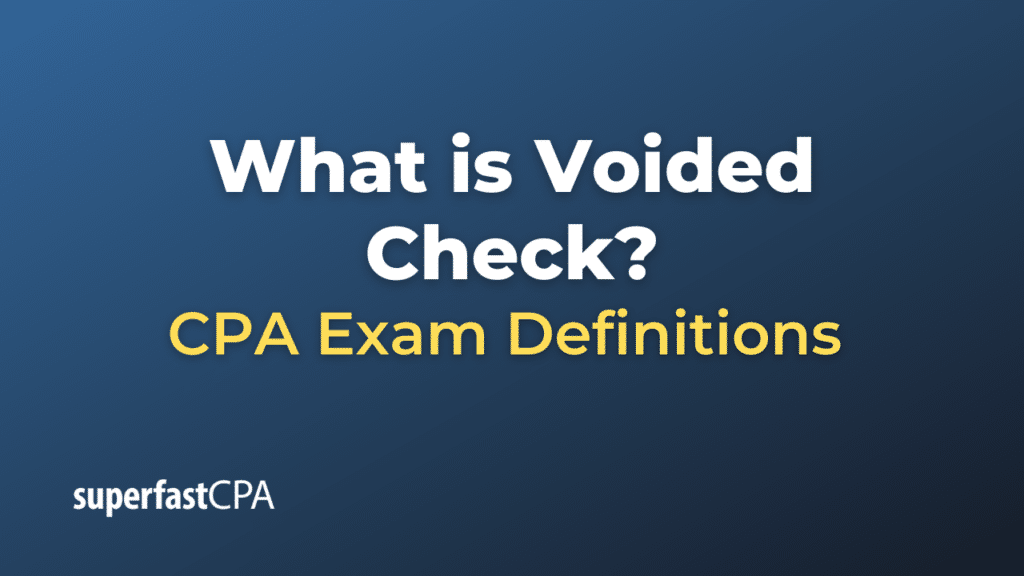Voided Check
A voided check is a check that has the word “VOID” written across it, which prevents anyone from filling out the check and using it to make a payment. Voided checks are rendered unusable regarding their original purpose but can still be useful for providing information, primarily the bank routing number and account number.
Purposes of a Voided Check:
- Setting Up Direct Deposit: When starting a new job, you may be asked to provide a voided check to set up direct deposit for your paycheck. The voided check gives your employer the information needed to deposit your pay directly into your bank account.
- Automatic Bill Payments: When setting up automatic monthly payments for bills like utilities or a mortgage, a company might request a voided check to process the payments automatically.
- Verifying Bank Account : Sometimes a voided check is used to verify the existence of a bank account.
- New Account Setup: Some financial services may require a voided check to set up a new account, especially when a link to a bank account is required for funding or payments.
- Preventing Fraud: If you make a mistake while writing a check, you may void it to prevent anyone from using it fraudulently.
How to Void a Check:
- Use a Pen: Take a regular pen, preferably one with permanent ink.
- Write “VOID”: Write “VOID” in large letters across the front of the check. Make sure not to cover the numbers at the bottom—the routing number and account number. These numbers are required for setting up direct deposits or other transactions.
- Record Keeping: Make a record that you voided the check and keep any stub or carbon copy if available. This ensures you have a record of the check number and the fact that it was voided.
- Notify Other Parties: If the voided check was originally written to someone else, make sure to let them know it has been voided and why.
- Secure Storage: Keep the voided check in a safe place until it’s needed or properly dispose of it if it’s not required. Some people choose to shred voided checks that are not needed for records.
- Digital Methods: In some cases, a digital image of a voided check or an online form may replace the need for a physical voided check.
Voided checks are a simple but effective tool for multiple financial processes, allowing for the secure transfer of necessary banking information without the risk of unauthorized payments.
Example of Voided Check
Let’s look at a common example involving setting up direct deposit for a new job.
Imagine you’ve just started a new job, and your employer offers you the option to receive your paycheck through direct deposit. To set this up, the HR department asks you for a voided check.
Steps You Take:
- Grab a Check: You take one blank check from your checkbook.
- Write “VOID”: Using a pen with permanent ink, you write “VOID” in large letters across the front of the check. You are careful not to write over the routing and account numbers at the bottom of the check, as these are needed for the direct deposit setup.
- Record Keeping: You make a note in your check register or financial software, indicating that you’ve voided the check. If your checkbook has duplicate slips, you keep the duplicate as a record.
- Submission: You hand over the voided check to your employer’s HR department. They use the routing number and account number printed on the check to set up your direct deposit.
- Confirmation : A few days later, HR confirms that the direct deposit setup is complete and informs you that you’ll receive your paychecks directly into your bank account from the next payment cycle.
- Safe Storage: If you had used a duplicate check or made a photocopy for your records, you store it in a safe place.
- Monitor the First Deposit: When you receive your first paycheck via direct deposit, you verify that the amount has been correctly deposited into your account.
Outcome:
By providing a voided check, you’ve enabled your employer to gather the necessary information for direct deposit without exposing yourself to the risks associated with an active, filled-out a. Your paycheck is now directly and securely deposited into your bank account, saving you the hassle of depositing checks manually.
This example illustrates a common use case for a voided check and outlines the steps one would typically go through in the process.













